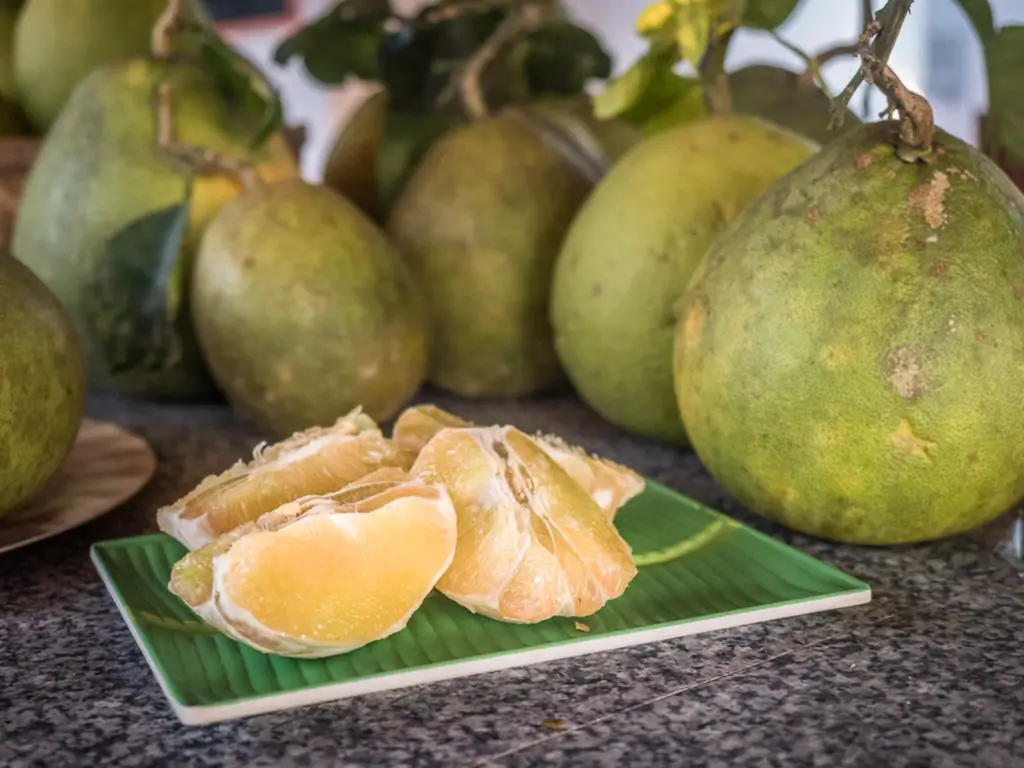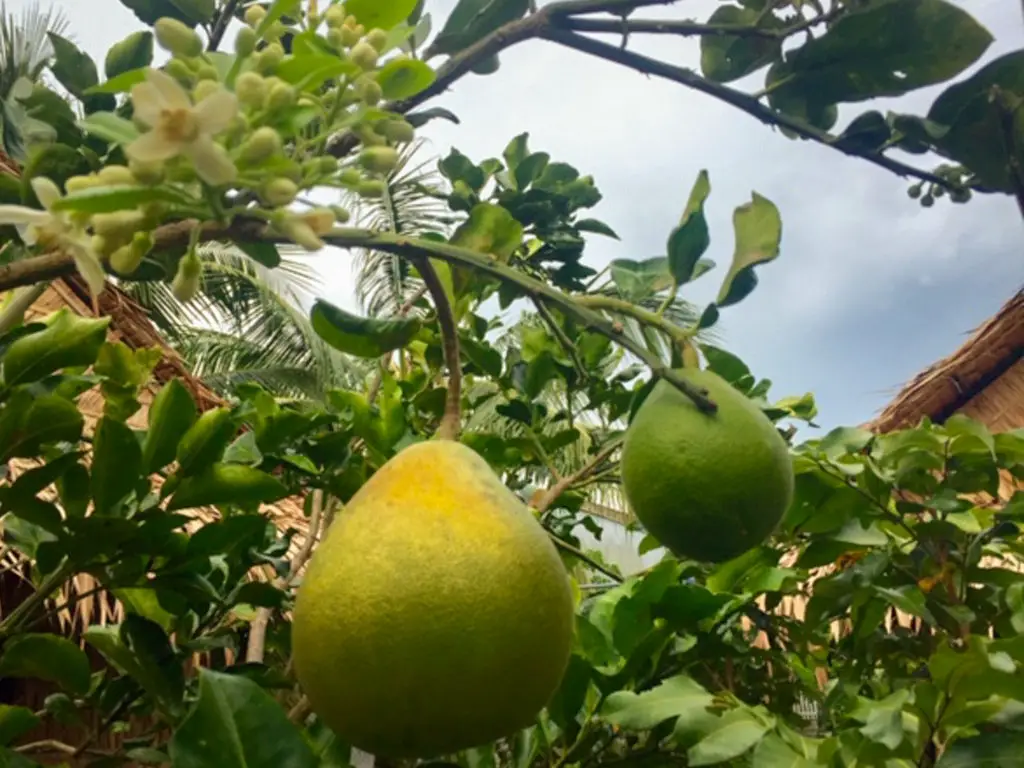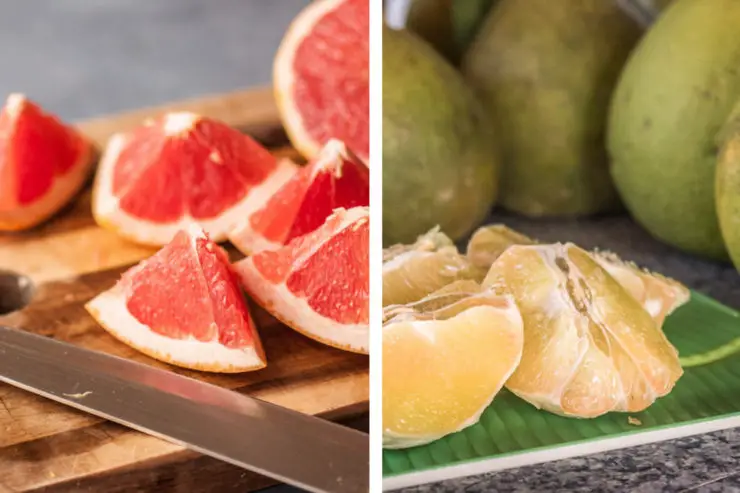As an Amazon Associate I earn from qualifying purchases. Please read the disclaimer for more info.
Two citrus fruits, pomelos and grapefruit, are awfully similar. In fact, a grapefruit actually derives from the pomelo. Despite that fundamental similarity, these fruits have distinctions that make each unique. Both delicious and tasty any time of the year, let’s discuss pomelo vs grapefruit:
Pomelo and Grapefruit Looks

Right off the bat, it’s easy to distinguish between a pomelo and a grapefruit because the two fruits have distinct looks. Pomelo has a green to yellow rind, depending on its ripeness, and it’s quite a big fruit, sometimes growing to the size of a watermelon. Most citrus fruits are round, but pomelos have more of a pear shape – a round bottom with a slightly rounded point at the top.
Grapefruit has a more classically citrus look. Its rind ranges in color from light orange to yellow, again depending on its ripeness, and it’s similar in size to an orange. Grapefruits also have a spherical shape, making them look different from pomelo.
The difference in the look of a pomelo vs. grapefruit doesn’t end on the outside, however. Their insides differ a bit, too. Although the flesh of both fruits naturally separates into wedges, the color and size are quite different.
A pomelo, as discussed, is much larger than a grapefruit, so its flesh is more prominent, too. It’s the same shape as a grapefruit’s flesh, just bigger in size. Each fruit’s flesh is also a different color. A pomelo’s flesh ranges from yellow to pink but always has a pale hue. A grapefruit’s flesh, however, is very rich in color, whether it’s light orange or deep red.

Their Taste
Pomelos and grapefruits are similar in many ways, but they are perhaps the most similar in taste. As noted, a grapefruit comes from a pomelo, so its genetic makeup is very similar, giving it that familiar taste.
A grapefruit, like many fruits, changes in taste depending on its ripeness. When it’s ripe, grapefruit has a delicious flavor similar to that of an orange. If it’s unripe, though, it’s got a very bitter taste that often deters people from eating it – or causes them to sprinkle some sugar, making it very toothsome.
Pomelo has a sweet taste all the time. Many of its fans describe it as tasting like a grapefruit without the bitter flavor. Both fruits have the classic citrus texture that is tasted in lemons, limes, oranges, and the like.

Pomelo vs Grapefruit Nutritional Info
Because of their significant size difference, pomelo and grapefruit have very different basic nutrition facts. As expected, pomelo is much higher than grapefruit in calories, carbohydrates, potassium, fiber, vitamin C, and protein. That being said, you’re unlikely to eat an entire pomelo in one sitting.
It’s arguably more important to look at the health benefits of these two fruits. Because they’re both citrus fruits, their benefits are nearly identical but differ just a bit. Both are known for their high nutritional value, antioxidants, high fiber content, weight loss promotion, and heart health benefits, but each has health benefits that the other doesn’t.
Pomelo is thought to have anti-aging properties, anti-bacterial and anti-fungal properties, and the potential to fight cancer cells. Grapefruit is said to be great for the skin, an excellent immune booster, very hydrating, able to fight kidney stones, and able to prevent insulin resistance. Both fruits are very healthy snacks that will undoubtedly benefit your body.
Grapefruit and Pomelo Uses

Because of all their similarities, pomelo and grapefruit are often used in similar ways. However, because grapefruit is more widely distributed, there are more recipes and uses that call for them than their larger citrus counterpart.
Think of pomelo like you would any other citrus fruit. It can be used in cooking and baking, as a garnish, as an ingredient in cocktails, and as an ingredient in beauty products. Pomelo goes well with other fresh produce, making it perfect for salads. It also brings out a fresh taste in many underwater proteins, such as shrimp and tuna.
Grapefruit is used very similarly. It can be found in vegetable salads, fruit salads, seafood dishes, and baked goods. Because it’s sometimes used as a substitute for oranges, grapefruit is often served alongside poultry as a glaze or a garnish. Grapefruit is also sometimes used as a household cleaner due to its acidity and fresh scent or as an ingredient in skin masks due to its high vitamin C levels.
Their Cultivation

Pomelos originally come from southeastern Asia and Malaysia, so they need a tropical or subtropical climate to grow. They are not widely available in the United States, but they are grown in parts of California and Florida.
Because of their growing climate, pomelos are in season the entire year, but the best time to eat them is from December to February. This is when they taste the best and grow the biggest.
Grapefruit’s country of origin is not certainly known, but it is thought that it was first created in Barbados. At any rate, grapefruit requires a subtropical climate to grow, so not many places in the United States can accommodate its cultivation, the bulk coming from Florida, Texas, Arizona, and California.
Grapefruit season depends on where it’s grown. In Arizona and California, grapefruit is in season from January to August, while in Texas and Florida, it grows well from October until June. This means that delicious grapefruit can be enjoyed in the United States almost any time of the year!
Other Similar Fruits

By now, you’re well aware that grapefruit and pomelo are both in the citrus family, but many other less common citrus fruits are similar. Aside from lemons, limes, and oranges, citrus fruits similar to grapefruit and pomelo include:
- Tangelo
- Citron
- Yuzu
- Rangpur
- Clementine
- Kumquat
- Oroblanco
- Cara Cara navel
Keep your eyes peeled for more citrus fruits, and if you come across one, or a grapefruit or pomelo, give it a try!

